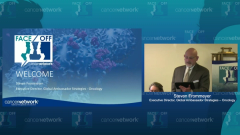
Use of Inotuzumab for ALL in the Frontline Setting
Nikesh Shah, MD, presents a trial published in Lancet Oncology in 2018 on the use of inotuzumab plus mini-CVD in the frontline setting for older patients with ALL.
Episodes in this series

Steven Frommeyer: At this time, Dr Shah, I’d like to hand the mic over to you for you to kick us off.
Bijal D. Shah, MD: Awesome. Welcome. Dr Nikesh Shah is going to start us off. He’s a third-year fellow in hematology and oncology. He’ll be joining Eduardo Sotomayor at the Tampa General Hospital Cancer [Institute] starting next year. I’ve worked with Nikesh for a while. He’s a good guy, and you guys are in trouble. That’s all I have to say.
Nikesh Shah, MD: Thank you. All right, I get to go first. First of all, thank you all for having me. Thank you all for organizing this. This is very exciting. I wanted to start things off by talking about a trial by Dr Hagop Kantarjian [The University of Texas MD Anderson Cancer Center] and colleagues published in Lancet Oncology in 2018 focusing on the use of inotuzumab [Besponsa] plus mini-CVD [reduced-dose cyclophosphamide, vincristine, and dexamethasone] in the frontline setting for older patients with ALL [acute lymphoblastic leukemia].
For a little background, we all know that older patients with ALL unfortunately have dismal outcomes. Their median survival is less than 1 year from diagnosis. This is for a variety of reasons. Older patients have a higher risk of adverse biology, more Ph [Philadelphia chromosome]–positive disease, and more TP53 mutations. They have decreased fitness and more comorbidities. They have a higher induction mortality. Many of these patients aren’t candidates for transplant. We’re going to talk about targeted therapies a lot today. Inotuzumab ozogamicin is an antibody-drug conjugate targeting CD22 with a linker to the calicheamicin toxin, which is internalized into the cell and causes DNA damage and apoptosis.
This trial that we’ll be discussing is a phase 2 single-arm study evaluating the safety and efficacy of inotuzumab with mini-CVD. They enrolled patients with newly diagnosed Ph-negative ALL, all of whom were 60 years or older. They allowed patients to have less than 1 week of prior therapy, pre-phase therapy, or they allowed patients who had 1 prior cycle of therapy as long as they were in CR [complete response]. These were older patients, so they allowed ECOG 3 or better, and you had to have adequate organ function with no second active malignancy.
The treatment protocol was 4 cycles of inotuzumab plus 8 cycles of mini-CVD. You can see the details of the mini-CVD regimen and inotuzumab here and the dose reductions in mini-CVD as compared with the traditional hyper-CVAD [cyclophosphamide, vincristine, doxorubicin, dexamethasone] protocol. Inotuzumab was initially started at 1.8 mg/m2 in cycle 1 followed by 1.3 mg/m2 in cycles 2 to 4. This was later amended multiple times, but first amended to 1.3 mg/m2 in cycle 1 followed by 1 mg/m2 in cycles 2 to 4. This induction was followed by POMP [prednisone, vincristine, methotrexate, 6-mercaptopurine] maintenance, and the decision for allogeneic stem cell transplant was per the treating physician. End points are listed here. There were multiple amendments that we’ll discuss at the end.
As far as the results, they enrolled 52 patients, 48 of which were treatment-naïve, and 4 of which had 1 prior cycle and were in complete response. Patients had a median age of 68 years, and all of them were older than 60. They had a high level of CD22 expression. Overall response rate was 98%, CR rate was 85%, and rate of MRD [minimal residual disease] negativity was 78%. You can see in the KM [Kaplan-Meier] curve on the right that patients had a 2-year overall survival of 66% and a 2-year PFS [progression-free survival] of 59%. You can see the curves plateau after 3 years.
Regarding toxicity and tolerance, we can see that patients received a median of 4 cycles of induction therapy. Almost half the patients had to switch to maintenance early rather than getting the planned 8 cycles because of toxicity, myelosuppression, and infections. Sixty-five percent of patients received the 4 total doses of inotuzumab. The main toxicities patients experienced were prolonged thrombocytopenia in 81% of patients, infection grade 3 or higher in almost all patients, and liver dysfunction grade 1 to 3 in almost all patients.
When we’re talking about inotuzumab, we have to talk about veno-occlusive disease [VOD]. They reported 4 patients with VOD, 1 of those with grade 5 VOD, and 3 of the 4 patients who had VOD ended up dying at some point. Only 1 of those patients recovered. There were 6 deaths that were determined to be treatment-related and there were 12 deaths in CR, mostly as a result of infection or VOD.
Overall, this was a well-designed study. They enrolled older, more frail patients, which is an at-risk population. There were multiple weaknesses. It was a single-arm study. I would have loved to see a comparator arm. There were some broad enrollment criteria. They enrolled patients who had already received some prior therapy. There were multiple amendments, which makes it a little hard to tease out. We need some more subgroup analyses here. I would have loved to see some discussion of a frailty index or geriatric assessment because this is targeted at older patients. Ultimately, treatment-related toxicity and VOD are still a problem.
Transcript edited for clarity.
Newsletter
Stay up to date on recent advances in the multidisciplinary approach to cancer.


















































































